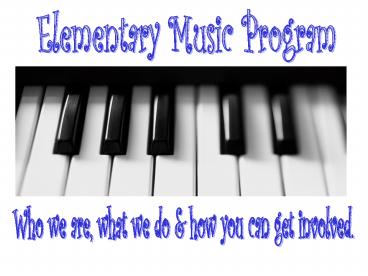Elementary Music Program - PowerPoint PPT Presentation
1 / 13
Title: Elementary Music Program
1
Elementary Music Program
Who we are, what we do how you can get involved.
2
What we offer
Orchestra
General music classes
Choir
Band
3
Music in our schools...
- Adams
- Carpenter
- Chestnut Hill
- Chippewassee
- Cook
- Eastlawn
- Longview
- Mills
- Parkdale
- Plymouth
- Siebert
- Woodcrest
4
First and Second Grades
- Singing
- learning to sing on pitch within a limited
comfortable range - learning to hear a short melody and sing it back
- Movement and Rhythm
- able to demonstrate a feel for the beat through
fundamental movements - able to follow directions in performing simple
singing games and dances - able to imitate rhythmic sounds and chant rhythms
- developing skill in playing simple rhythm and
melody instruments - Music Reading
- able to recognize symbols for simple notation
- beginning to take simple one or two measure
rhythmic dictation - Playing Classroom Instruments
- introduced to and developing skills in playing
melodic and rhythmic instruments - Listening
- able to identify pitch relationships as higher,
lower, or the same
5
Third and Fourth Grades
- Singing
- improving in ability to sing accurately within an
expanded range - developing the ability to sing rounds and
ostinati within a group - Movement and Rhythm
- displays a recognition of even and uneven rhythms
- aware that music moves in 2s or 3s.
- Playing Classroom Instruments
- improving skill in playing melodic and rhythmic
instruments - discovering the expressive possibilities of
various instrument combinations - Music Reading
- has knowledge of the letter names of the treble
clef staff - learns the significance of the top number in time
signatures - recognizes repeat sign, bar line, measure, double
bar, dynamic markings and fermata - Listening and Form
6
Fifth Grade
- Singing
- demonstrating improvement in tone production and
diction - introduced to singing in rounds, descants, and
partner songs - distinguishes between duple and triple meter
- Playing Classroom Instruments
- exhibiting increased skill in playing ostinati
and descants - playing simple melodic patterns on melodic
instruments from notation - Music Reading
- understands most frequently encountered time
signatures and note values - recognizes existence of triplets, dotted notes,
and syncopation - Listening
- able to recognize differences in tonalities
- listening with increased perception to a wide
variety of music - identifying contemporary instrumentation (rock,
jazz, electronic, etc) - learning to be musically tolerant and is learning
to formulate positive attitudes
7
Choir
- How is music class different from choir?
- Music class offers a broad music education in all
areas, such as concepts in rhythm, pitch, music
history, form, genre and basic notation. - Choir is a performance group which focuses on
vocal technique and application of musical
knowledge and skills acquired through music
class. These skills are demonstrated through
selected repertoire in concert.
8
More about choir...
- Choir meets once each week, in addition to music
class. - Choir meets during the regular school day.
- Fifth grade students may play an instrument in
the band or orchestra and also sing in the choir.
9
Instrumentally Speaking...
- Fifth grade students have the opportunity to join
their instrumental music program. - Our goal is to provide students with a
challenging, fun, and enriching musical
experience that will provide a solid foundation
for participation in the middle and high school
instrumental program. - Instruments and instruction are provided by the
school.
10
Band
- Anyone can learn to play an instrument with a
little time and practice. Along with learning to
play your instrument you will also learn to read,
count, and interpret music. - The instruments taught in the band program are
Flute, Clarinet, Trumpet, Trombone and
Percussion. - Choose the right instrument for you. You might
want to consider which instruments sound you
like the best, and which one you would most like
to see yourself playing. You will also have an
opportunity to try a couple of instruments before
making your final choice. - If you have a strong interest, practice
regularly, ask for help when you need it, and
attend band class regularly, you will be very
successful! Parent support and encouragement
also play an important role.
11
Orchestra
- The instruments taught in the orchestra program
are Violin, Viola, Cello and Bass. - Classes meet three times each week, usually with
two classes before or after school and one class
during the school day. - Students play from a book one method and play
motivational pieces as well. - Students will perform in several concerts during
the year. - Our goal is to provide your child with a
challenging and satisfying skill that will last a
lifetime.
12
- When a child learns by experience that music
forges direct links between self and world,
self-expression becomes more fluent the music
helps interpret - "who I am."
Growing up Complete, the report of the National
Commission on Music Education, 1990
13
So, "Hear's the Pitch...."
- Contact your elementary school music teachers.
- Visit music class, choir, band and orchestra
rehearsals. - Find out more about the Midland Public Schools
Music Program. - Make music a part of your childs life.































